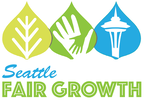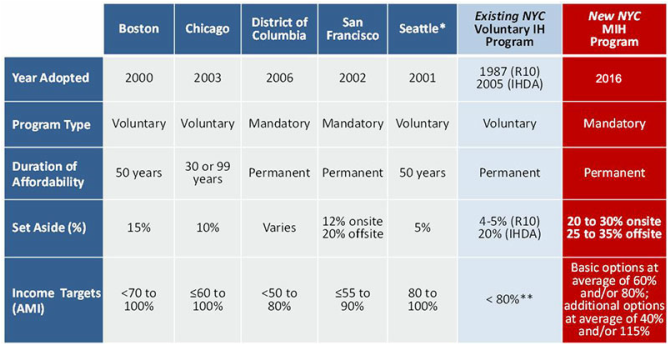|
by Sarajane Siegfriedt
Alex Pedersen has denounced dark money, corporate PACs and refused any corporate donations. He was the first in the city to qualify for Democracy Vouchers. His #1 priority is housing and homelessness and his vote is "owned" by the voters whose doors he knocked on. Scott says good stuff but he doesn't have the experience to get things done. His resume is paper-thin. He wants to head Planning, Land Use and Zoning, the most technical committee. Scott's positions are in support of unlimited development. I can't understand a Socialist giving free hand to Downtown Developers. Vote for Pedersen.
0 Comments
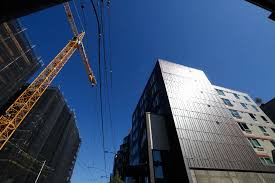 by Shirley Nixon and Nancy Bocek, co-leads of Livable U District Increasing allowable building heights in the U District by 400% to nearly 500% in many cases (current 55’, 65 and 85'maximums to 240’ and 320’) is a too massive and unnecessary upzone! The U District is indeed to become a sacrifice zone, with its unique character destroyed forever. We need to tell our elected officials that this upzone proposal is unacceptable, unsupportable and unfair. But Council Member Rob Johnson seems determined to vote it out of his PLUZ Committee and adopted by the full council in just a few short weeks. If this is to be prevented, City Council members must hear now from residents and independent business owners who want a more Livable U District and First Things First instead of an upzone ordinance that will only blanket the community with taller densely packed buildings, less livability, and more displacement. Where do we fit in all this? Dispelling the myth that this upzone is what "the community" wants and needs. Read More... 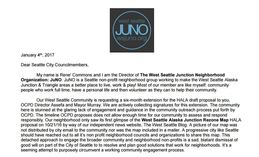 The West Seattle Junction Neighborhood Organization, JuNO, sent a letter to City Council requesting a six month delay on the HALA draft proposal before proceeding to an Environmental Impact Study or EIS. Please see the attached letter for an outline of their concerns, which include a lack of neighborhood outreach by the city and not enough time for the neighborhood to responsibly study and respond to the proposed rezones. If you would like more info on JuNO and how to get involved, please email: [email protected]
 by Lisa Parriott In 2012, Dianna McLeod, a senior citizen, called the City of Seattle’s DPD and asked if her side yard was a buildable lot. She was told no. Immediately following, developer Dan Duffus bought her property, split the lot in 2, built and sold a towering toaster box house on the new lot for a large profit. Our neighbor, a senior citizen, contracted with a professional real estate agent to sell his home with a large side yard. His north Admiral (West Seattle) property sold for $505,000 less than 14 months ago to developer Cliff Low. He now lives in a trailer park in Puyallup. On January 12, 2017, 9AM @ Seattle Municipal Tower in Parriott vs. City of Seattle, the neighbors will make the case to the City’s Hearing Examiner that the side yard is not a separate building site, based on a 1957 City LU Code loophole – Historic Lot Exception. If unsuccessful, Cliff Low will have secured a vacant lot in Seattle for little to no money. He will be allowed to squeeze a towering toaster box home onto the side yard and walk away with over $400,000 profit. read more...
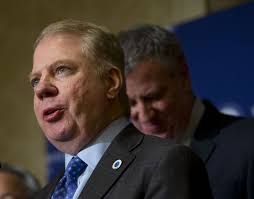 by Jon Lisbin The Seattle City Council is considering massive upzones in the University District as the first implementation of it's "Inclusionary Housing" strategies throughout the city. Truth is, if I was Mayor, I may have taken the same approach. Put together a panel of experts and stakeholders to come up with strategies to address Seattle’s affordable housing crisis. Unfortunately, that’s where intelligence ended and corruption began. The composition of HALA (Housing and Livability Agenda) Committee was heavily weighted toward developers and their interests. The resulting skewed report was biased towards special interests. I know, at this point you are saying “another conspiracy theorist”. However, the facts behind my assertion are quite compelling. Maybe I can speak in a language city officials are familiar with?
I know the train has left the station. I know it would take true courage to stop it now. I ask that our city leaders have that courage! * Seattle's current plan calls for 3 - 8% Set Asides, significantly below other major cities, but not set yet.
Public Comment at City of Seattle Hearing re: Proposed Upzone of the University District11/20/2016  by Linda Nash and Jim Hanford 2016 will be the hottest year on record. Atmospheric carbon levels are now higher than they have been in 4 million years. Seattle has admirably made the commitment to carbon neutrality by the year 2050. Locating new housing and businesses near transportation is an important step. But that alone is not enough. One-third of Seattle’s energy use comes from buildings. In order to achieve carbon neutrality while continuing to grow, the City will have to transition the vast majority of its building stock away from the consumption of electricity and fossil fuels. Yet high-rise construction, as proposed here, is a high-carbon option. Seattle’s own data show that high-rise multi-family buildings currently consume 45% more energy per square foot than mid-rise multi-family and 64% more than low-rise multi-family. In the case of tall buildings, the emphasis on small efficiency improvements and “LEED” certification merely serves to make wasteful construction slightly less unsustainable. There are significant obstacles to making tall buildings energy and carbon efficient: they require more elevators and air-conditioning; they have more exposure to wind and sun and have higher rates of heat gain and loss; they have a small roof-top area limits the potential to use solar and other renewables. To make matters worse, tall buildings exacerbate the effects of very high temperature days (which we are now experiencing in the summer) by raising surrounding air temperatures and decreasing air flow between buildings. Their long shadows also limit the potential for solar energy on adjacent sites. If Seattle truly wants to mitigate climate change, it will need to prioritize energy considerations in zoning and the design of buildings. Modern, tower-dominated downtowns emerged in an era of cheap and abundant fossil fuels, and they do not obviously serve the needs of the twenty-first century. Buildings last for many decades and will shape the city’s design and energy needs far into the future. We can’t afford not to get it right. Read more by Jim Hanford: High-rises are energy hogs, not climate solutions  A series of documents have been posted on the “What’s Happening” tab, and under the “Growth with Affordability” link. In the Citywide Implementation of MHA box on this page are the following three documents related to the EIS scoping.
|
||||||||||
Contact Us
Subscribe
Join our mailing list today!
